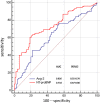Angiopoietin-2 provides no incremental predictive value for the presence of obstructive coronary artery disease over N-terminal pro-brain natriuretic peptide
- PMID: 31257664
- PMCID: PMC6805287
- DOI: 10.1002/jcla.22972
Angiopoietin-2 provides no incremental predictive value for the presence of obstructive coronary artery disease over N-terminal pro-brain natriuretic peptide
Abstract
Background: Using circulating biomarkers as a noninvasive method to assist the evaluation of coronary artery disease (CAD) is beneficial for reducing the unnecessary diagnostic cardiac catheterization. This study aimed to assess the predictive role of angiopoietin-2 (Ang-2) for the presence of obstructive coronary stenosis as compared with N-terminal pro-brain natriuretic peptide (NT-proBNP) in patients with symptoms of CAD.
Methods: The study enrolled 222 consecutive symptomatic patients who underwent elective diagnostic cardiac catheterization from July to December 2018. Blood samples were collected in the first morning after admission. The severity of coronary stenosis was assessed by coronary angiography. The obstructive CAD was defined as stenosis ≥50% of the left main coronary artery or stenosis ≥70% of a major epicardial vessel (left anterior descending artery, left circumflex artery and right coronary artery).
Results: Patients with obstructive CAD (n = 120) had significantly higher levels of Ang-2 and NT-proBNP compared with those without. In multivariable regression analysis, only NT-proBNP levels were independently associated with Ang-2 levels. NT-proBNP was superior to Ang-2 as a predictor for the presence of obstructive CAD (NT-proBNP, area under curve [AUC] = 0.733, vs Ang-2, AUC = 0.626, P = 0.004). In multiple logistic regression analysis, NT-proBNP, but not Ang-2, was the independent predictor of obstructive CAD. The combination of Ang-2 with NT-proBNP did not provide the incremental value over NT-proBNP alone.
Conclusion: Serum Ang-2 levels are associated with NT-proBNP levels in patients suspected for CAD. NT-proBNP is superior to Ang-2 as a predictor for the presence of obstructive CAD. However, Ang-2 does not further increase diagnostic accuracy on top of NT-proBNP.
Keywords: NT-proBNP; angiopoietin-2; biomarkers; coronary artery disease; diagnostic cardiac catheterization.
© 2019 The Authors. Journal of Clinical Laboratory Analysis Published by Wiley Periodicals, Inc.
Figures
Similar articles
-
Effect of Coronary Atherosclerosis and Myocardial Ischemia on Plasma Levels of High-Sensitivity Troponin T and NT-proBNP in Patients With Stable Angina.Arterioscler Thromb Vasc Biol. 2016 Apr;36(4):757-64. doi: 10.1161/ATVBAHA.115.306818. Epub 2016 Feb 11. Arterioscler Thromb Vasc Biol. 2016. PMID: 26868212
-
N-terminal pro-brain natriuretic peptide used for the prediction of coronary artery stenosis.Eur J Clin Invest. 2007 Jan;37(1):18-25. doi: 10.1111/j.1365-2362.2007.01731.x. Eur J Clin Invest. 2007. PMID: 17181563
-
The severity of coronary artery disease and reversible ischemia revealed by N-terminal pro-brain natriuretic peptide in patients with unstable angina and preserved left ventricular function.Peptides. 2014 Feb;52:143-8. doi: 10.1016/j.peptides.2013.12.018. Epub 2014 Jan 8. Peptides. 2014. PMID: 24412773 Clinical Trial.
-
N-terminal prohormone B-type natriuretic peptide and cardiovascular risk in stable coronary artery disease: a meta-analysis of nine prospective studies.Rev Cardiovasc Med. 2013;14(2-4):e92-8. doi: 10.3909/ricm0644. Rev Cardiovasc Med. 2013. PMID: 24448259 Review.
-
Role of B-type natriuretic peptide (BNP) and NT-proBNP in clinical routine.Heart. 2006 Jun;92(6):843-9. doi: 10.1136/hrt.2005.071233. Heart. 2006. PMID: 16698841 Free PMC article. Review. No abstract available.
Cited by
-
Angiopoietins, Vascular Endothelial Growth Factors and Secretory Phospholipase A2 in Ischemic and Non-Ischemic Heart Failure.J Clin Med. 2020 Jun 19;9(6):1928. doi: 10.3390/jcm9061928. J Clin Med. 2020. PMID: 32575548 Free PMC article.
-
Association between serum angiopoietin-2 concentrations and periprocedural myocardial injury in patients undergoing elective percutaneous coronary intervention.Aging (Albany NY). 2020 Mar 17;12(6):5140-5151. doi: 10.18632/aging.102936. Epub 2020 Mar 17. Aging (Albany NY). 2020. PMID: 32182213 Free PMC article.
-
The Clinical Role of Angiopoietin-Like Protein 3 in Evaluating Coronary Artery Disease in Patients with Obstructive Sleep Apnea.Cardiovasc Drugs Ther. 2020 Dec;34(6):773-780. doi: 10.1007/s10557-020-06991-1. Cardiovasc Drugs Ther. 2020. PMID: 32440963 Free PMC article.
References
-
- Bittencourt MS, Hulten EA, Murthy VL, et al. Clinical Outcomes After Evaluation of Stable Chest Pain by Coronary Computed Tomographic Angiography Versus Usual Care: A Meta‐Analysis. Circ Cardiovasc Imaging. 2016;9(4):e004419. - PubMed
-
- Ibrahim NE, Januzzi JL Jr, Magaret CA, et al. A Clinical and Biomarker Scoring System to Predict the Presence of Obstructive Coronary Artery Disease. J Am Coll Cardiol. 2017;69(9):1147‐1156. - PubMed
-
- Oka T, Akazawa H, Naito AT, Komuro I. Angiogenesis and cardiac hypertrophy: maintenance of cardiac function and causative roles in heart failure. Circ Res. 2014;114(3):565‐571. - PubMed
MeSH terms
Substances
Grants and funding
LinkOut - more resources
Full Text Sources
Medical
Research Materials
Miscellaneous



